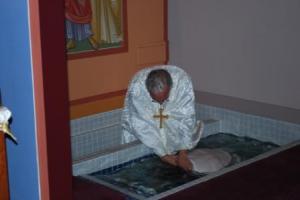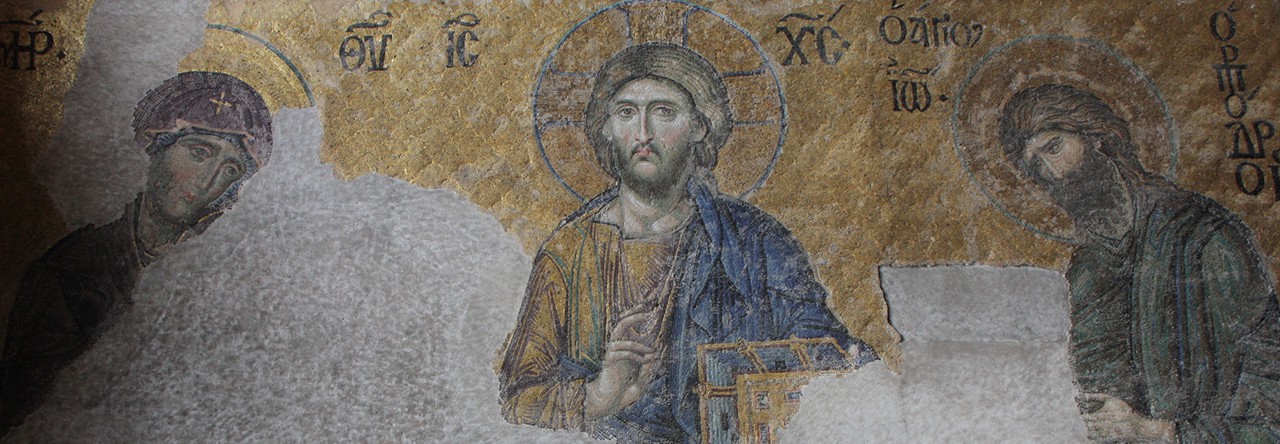 “Ordained in the sacrament of baptism by water and the Spirit to be king and priest, the newly enlightened Christian is solemnly led into the Eucharistic assembly. ‘But we, after we have thus washed him who has been convinced and has assented to our teaching, bring him to the place where those who are called brethren are assembled, in order that we may offer hearty prayers in common for ourselves and for the baptized (illuminated) person, and for all others in every place. . . .
“Ordained in the sacrament of baptism by water and the Spirit to be king and priest, the newly enlightened Christian is solemnly led into the Eucharistic assembly. ‘But we, after we have thus washed him who has been convinced and has assented to our teaching, bring him to the place where those who are called brethren are assembled, in order that we may offer hearty prayers in common for ourselves and for the baptized (illuminated) person, and for all others in every place. . . .
 Having ended the prayers, we salute one another with a kiss. There is then brought to the president of the brethren bread and a cup of wine mixed with water; and he taking them, gives praise and glory to the Father of the universe, through the name of the Son and of the Holy Ghost, and offers thanks at considerable length for our being counted worthy to receive these things at His hands. And when he has concluded the prayers and thanksgivings, all the people present express their assent by saying Amen. . . .
Having ended the prayers, we salute one another with a kiss. There is then brought to the president of the brethren bread and a cup of wine mixed with water; and he taking them, gives praise and glory to the Father of the universe, through the name of the Son and of the Holy Ghost, and offers thanks at considerable length for our being counted worthy to receive these things at His hands. And when he has concluded the prayers and thanksgivings, all the people present express their assent by saying Amen. . . .
 And when the president has given thanks, and all the people have expressed their assent, those who are called by us deacons give to each those present to partake of the bread and wine mixed with water over which the thanksgiving was pronounced, and to those who are absent they carry away a portion.’”
And when the president has given thanks, and all the people have expressed their assent, those who are called by us deacons give to each those present to partake of the bread and wine mixed with water over which the thanksgiving was pronounced, and to those who are absent they carry away a portion.’”
(St. Justin the Martyr – d. 165AD – in The Church of the Holy Spirit by Nicholas Afanasiev, pg. 33)

“Offers thanks at considerable length” nice to see some things haven’t changed! :-)
In this quote, Justin Martyr refers to the Eucharist as “bread and wine mixed with water” even after the consecration. Does he ever discuss the Real Presence?
Off the top of my head I don’t know the answer to your question, though the phrase “real presence” is probably something that came up much later in history. Some of the early writers probably also respected the sense of mystery and so did not offer a theological analysis of what they believed was happening in order to protect the mystery. In some early catechisms it is only after baptism that the new Christians have explained to them what they just experienced, and only then are they taught the Lord’s Prayer for the fist time. What were considered the mysteries were not explained to the catechumens before baptism.
CJ,
Here is what St Justin Martyr wrote about the Real Presence:
This food we call the Eucharist, of which no one is allowed to partake except one who believes that the things we teach are true, and has received the washing for forgiveness of sins and for rebirth, and who lives as Christ handed down to us. For we do not receive these things as common bread or common drink; but as Jesus Christ our Savior being incarnate by God’s Word took flesh and blood for our salvation, so also we have been taught that the food consecrated by the Word of prayer which comes from him, from which our flesh and blood are nourished by transformation, is the flesh and blood of that incarnate Jesus (First Apology 66)
Seems pretty clear to me.
Thank you both!